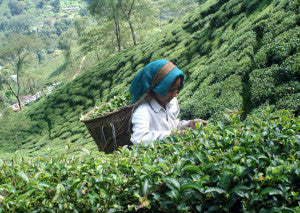
Tea: A Soulful Sip
By: Niraj Lama, Owner of Happy Earth Tea
I grew up playing hide and seek with my buddies in the tea bushes of Darjeeling, India. Those moments steeped in pure joy remain alive in my cup. To a great extent that is what drives my professional interest and passion for tea – a joyful intimacy with the crop that goes back to my childhood.
As an adult I appreciate the holistic nature of tea, how it nurtures both the body and the mind. It is one of the oldest beverages known to humanity and is still the highest consumed liquid after water.
Lured by work in the tea plantations that had just been laid out by the British colonialists at the turn of the 20th Century, my grandparents came to the Darjeeling hills from Nepal. Little did they know at that time that Darjeeling tea would soon become known as the “champagne of teas” in the tea-drinking world.
Tea, properly, is used to describe an infusion made from leaves of the plant camellia sinensis. The word itself comes from t’e, a word in Chinese Amoy dialect. The other popular word for tea, chai comes from the Mandarin ch’a. Notably, tea seeds and plants were brought to Darjeeling after they were smuggled out of China by the British.
Left un-pruned, a tea plant can actually grow to be a 15-20 feet tall tree. However, in the “tea gardens” - as these big tea plantations are called in India - the plants are kept waist-high for easier plucking. In many parts of the tea growing world, including Darjeeling, every leaf is hand plucked to ensure that only the highest quality leaf is harvested.
Tea can be broadly classified as black, green, yellow, white and post-fermented. The distinctions are based on the production method. And each tea has its own unique characteristics including flavor and taste. Tea prices range from being as expensive as gold - red robe oolong from Wuyimountain in China - to as cheap as your common crackers.
Until tea became popular in the US - which is quite recent - the emphasis on the health benefits of tea was limited. The Japanese had done a great deal of study of their green tea and its salutary effects, but besides that most of the tea drinking populace was happy to sip their tea without worrying too much about polyphenols and anti-oxidants. The rise in health awareness is a new and positive development.
Although tea is now touted as a cure-all, the main scientific findings so far include a catechin called EGC3G in green tea that is believed to help fight cancer and Alzheimer's among other diseases. In black tea, the flavonoids theaflavins and thearubigins help keep the arteries clear of build ups, thereby being particularly beneficial to the heart.
The health benefits are tremendous, but I am more drawn to the spiritual, artistic and social traditions of tea. The Zen roots of Chanoyu (Japanese tea ceremony) strengthen my Being. I revel in the poems, paintings and ceramics inspired by tea. I love the pomp of high tea (which actually began with the working class before the gentry adopted it), the skill of gong fu (tea brewed in short rapid succession), the timelessness of mint tea made by Bedouins in the desert, the energy of chai made by the street vendors in India, and the love of a grandma in her rose tea.
In its essence tea is simple - bringing hot leaves to water. Yet a cup of tea holds not just delicious and healthy liquor, but also rich and inspiring traditions.
Niraj will be teaching "Brewing Methods: Tea" on Tuesday, April 30th from 7-9pm. Check it out here!
